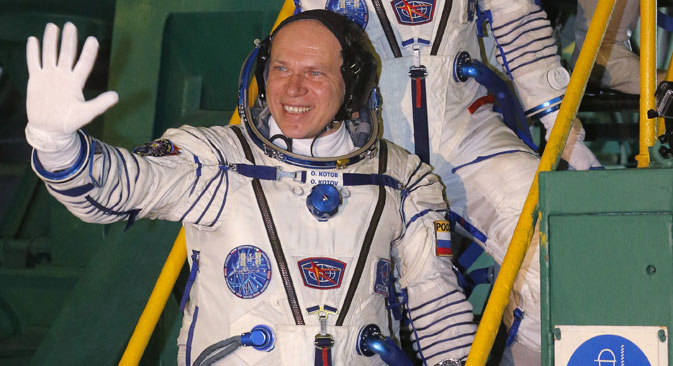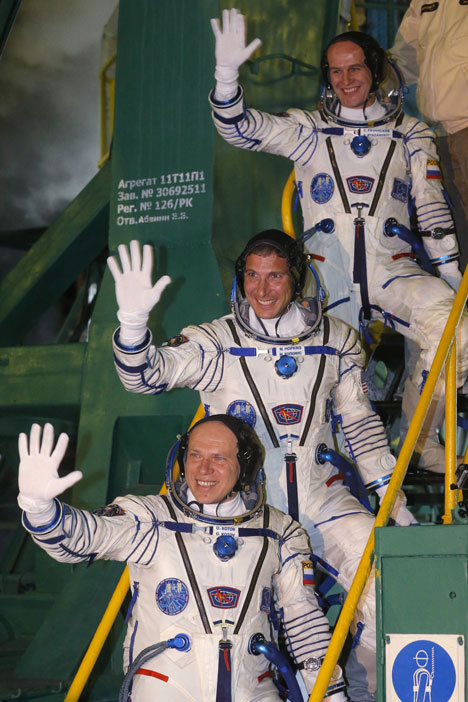
Oleg Kotov (bottom step), Mike Hopkins and Sergey Ryazanskiy about to embark on their 6-month stint on the space station. Source: RIA Novosti

Oleg Kotov (bottom step), Mike Hopkins and Sergey Ryazanskiy about to embark on their 6-month stint on the space station. Source: RIA Novosti
A few weeks ago, Russian Cosmonauts Oleg Kotov, Sergey Ryazanskiy and American astronaut Mike Hopkins returned to earth after a 6-month stint together on the International Space Station. Said Kotov: “I think that everyone agrees that all such missions need to be international because each country has its own experience, skills, knowledge, and combining all those assets will help us develop the deep space.”
April 12th marks the 53rd anniversary of Soviet cosmonaut Yuri Gagarin’s historic mission as the first man in outer space. Less than a year later, John Glenn would join him as the first American to orbit the Earth.
Competition between the two superpowers in space was once fierce. Russian-U.S. diplomatic relations may have deteriorated in recent years and months, but a partnership in their dual pursuit of space exploration is stronger than ever. Each is dependent on the other for continuing their successful missions.
In the late 1950s and early 1960s, the U.S. Defense Department feared the Soviets’ accomplishments in space would augment their ability to launch ballistic missiles. President John F. Kennedy, however, never hoped for a space race. He encapsulated this in his UN speech just two months before his death.
“Why… should man’s first flight to the moon be a matter of national competition? Why should the United States and the Soviet Union, in preparing for such expeditions, become involved in immense duplications of research, construction and expenditures?,” Kennedy asked in September 1963.
October 4, 1957 • Soviet Union launches Sputnik, the first satellite, into space.
April 12, 1961 • Russian cosmonaut Yuri Gagarin becomes the first human in space.
May 5, 1961 • Astronaut Alan Shepard becomes the first American in space.
July 20, 1969 • Neil Armstrong and “Buzz” Aldrin are the first men on the moon.
July 15, 1975 • The Apollo-Soyuz Test Project (ASTP), the first joint U.S.-Soviet space flight, is launched.
February 20, 1986 • The core section of the Space Station Mir is launched.
1992 • Roscosmos, the Russian Federal Space Agency, is formed.
February 3, 1994 • Sergei Krikalev becomes the first Russian cosmonaut to fly on a space shuttle.
1998 • A Russian rocket launches the first piece of the International Space Station (ISS).
October 2000 • The first crew arrives on the ISS.
October 11, 2010 • Barack Obama signs legislation focusing NASA’s efforts on exploring Mars and the asteroids.
December 10, 2010 • SpaceV, a private company, launches a spacecraft into orbit and it returns.
The Apollo 11 moon landing mission in July 1969 was the first step to transform the countries’ rivalry into an eventual partnership. July 1975 marked the first joint U.S.-Soviet space collaboration in the Apollo-Soyuz test flight.
A Soviet Soyuz capsule carrying two cosmonauts docked successfully with a U.S. module carrying three astronauts. Despite this successful mission, it would take another decade for the partnership to come into fruition.
Mir, which operated in low Earth orbit, became the first modular space station. Assembled in 1986, Mir held the record for the largest artificial satellite orbiting the earth.
The establishment of the Russian Federal Space Agency, better known as Roskosmos in 1992, would become the epicenter of the restoration of the country’s vaunted aerospace research and space program. Since its inception, the space agency has taken a leading role in commercial satellite launches and space tourism.
“The Russians need our money, and we need their space station,” said Clayton Anderson, a retired astronaut and a member of the Expedition 15 crew in 2007. Anderson spent 152 days on board the International Space Station (ISS), the microgravity and space environment research laboratory. On the ISS, crew members conduct experiments in biology, physics, astronomy and other fields.
President Barack Obama’s decision to cut funds devoted to planetary science in this year’s budget upset some scientists and space exploration groups. The plan, however, does involve increasing funding for Earth science missions, which intend to fully fund the agency’s private space taxi program and new human spaceflight projects, such as the Space Launch System’s mega-rocket and Orion space capsule.
This could ultimately end America’s reliance on Russia for space voyages.
“Virtually every aspect of the manned and unmanned U.S. space program… is highly dependent on Russian & Ukrainian rocketry,” Universe Today reported. “It is the Russians, which have to facilitate the space rides back and forth. The ISS, astronaut rides to space and back, the Atlas V and rockets and even critical U.S. spy satellites providing vital, real time intelligence gathering are among the examples of programs that may be in peril if events deteriorate or worse yet, spin out of control.”
NASA, however, announced last November that it is seeking to partner with U.S. companies for human trips to the station as well by 2017.
“Until commercial space companies are ready to consistently launch American astronauts safely into space — and it’s going to be a while before they are — we are beholden to our Putin-led compatriots from the Russian Federation,” Clayton Anderson added.
NASA has agreed to pay an estimated $71 million to ferry astronauts.
The joint-partnership of NASA and Roscosmos remains a boon for the U.S. and Russia “in the mutual pursuit of peaceful space exploration,” said Allard Beutel, a NASA spokesman.
“NASA and Roscosmos will continue to work with each other to maintain the space station, where humans have lived continuously for more than 13 years, and we are confident that our two space agencies will continue to work closely as they have throughout various ups and downs of the broader U.S.-Russia relationship,” Beutel added.
Take the landing of the Soyuz capsule in Kazakhstan on March 11. Missouri native Mike Hopkins landed in the Soyuz capsule, along with Oleg Kotov (a Crimean native) and flight engineer Sergey Ryazanskiy, a Russian cosmonaut, after the nearly six month mission.
“We need each other to operate the International Space Station,” Kotov said, shortly before his mission. Kotov, a space veteran, has served as a flight engineer and Soyuz commander on the ISS-6 and ISS-13 backup crews.
Hopkins underscored that politics never played a part in their joint mission:
“The politics got left aside because we did have a mission up there that we were all involved in, and we needed to work together, and we had the ground teams as well, both in Moscow, and here in Houston, worked very well together. So, the same kind of tensions you might see going on between the two countries we never experienced while we’re onboard.” Anderson scoffs at the suggestion that felt any of the geopolitical strain while in outer space:
“In space, they are my tri mushketera” [Three Musketeers].
All rights reserved by Rossiyskaya Gazeta.
Subscribe
to our newsletter!
Get the week's best stories straight to your inbox